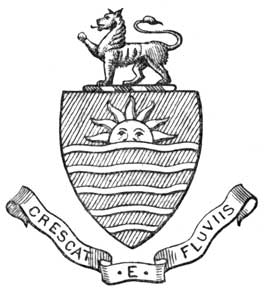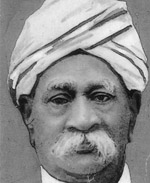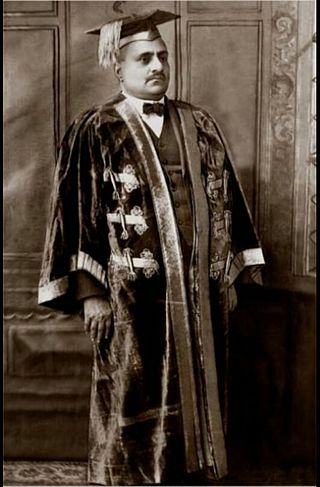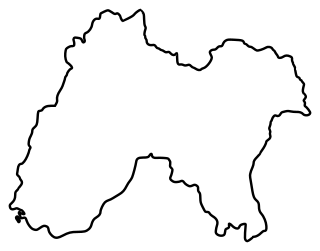The National Unionist Party was a political party based in the Punjab Province during the period of British rule in India. The Unionist Party mainly represented the interests of the landed gentry and landlords of Punjab, which included Muslims, Hindus and Sikhs. The Unionists dominated the political scene in Punjab from World War I to the independence of India and Pakistan in 1947. The party's leaders served as Prime Minister of the Punjab.

The British Punjab Legislative Council, or simply the Punjab Legislative Council, was the unicameral legislature of British Punjab, a province of the British Raj. It was established in 1921 by the British authorities under Government of India Act 1919, the council had nominal powers and a membership of mainly pro-British politicians and government officials. Voting was largely boycotted until the Government of India Act 1935 increased representation and the powers of the assembly. It was dissolved in 1936 and was succeeded by British Punjab Provincial Assembly.
Bombay Legislative Council was the legislature of the Bombay Province and later the upper house of the bicameral legislature of Bombay Province in British India and the Indian state of Bombay.
Sir Mian Fazl-i-Husain, KCSI was an influential politician during the British Raj and a founding member of the Unionist Party of the Punjab.

The Council of State was the upper house of the legislature for British India created by the Government of India Act 1919 from the old Imperial Legislative Council, implementing the Montagu–Chelmsford Reforms. The Central Legislative Assembly was the lower house.

The first legislative council election to Madras Presidency after the establishment of dyarchical system of government by the Government of India Act 1919, was held in November 1920. Indian National Congress boycotted the election due to its participation in the Non-cooperation movement. The election occurred during the early stages of non-Brahmin movement and the major issue of the election was anti-Brahminism. Justice party won the election with no significant opposition and A. Subbarayalu Reddiar became the inaugural First Minister of the presidency.

The fourth legislative council election to Madras Presidency after the establishment of dyarchical system of government by the Government of India Act, 1919 in September 1930. Justice party won the election and P. Munuswamy Naidu became the first First Minister. The main opposition party - Swaraj Party did not contest the elections due to its participation in the Civil Disobedience Movement.

The second legislative council election to Madras Presidency after the establishment of diarchical system of government by the Government of India Act, 1919 was held in 1923. Voter turnout was higher than the previous election. Swarajists, a breakaway group from Indian National Congress participated in the election. The ruling Justice Party had suffered a split, when a splinter group calling themselves anti-Ministerialists left the party. It won the highest number of seats but fell short of a majority. Nevertheless, Madras Governor Willington invited it to form the government. Incumbent Justice First Minister Panagal Raja was nominated by party leader Theagaraya Chetty to continue as First Minister for a second term. The government survived a no-confidence motion, brought against it on the first day of its tenure by the opposition headed by C. R. Reddy.
Diarchy was established in Madras Presidency based on the recommendations of the Montague-Chelmsford report. Five elections were held during the period diarchy was in effect and Justice Party occupied power most of the time. It ended with the election in 1937 when the Government of India Act 1935 came into effect.

When the All-India Muslim League was founded at Dacca, on 30 December 1906 at the occasion of the annual All India Muhammadan Educational Conference, It was participated by the Muslim leaders from Punjab, i.e., Sir Mian Muhammad Shafi, Mian Fazl-i-Hussain, Abdul Aziz, Khawaja Yusuf Shah and Sh. Ghulam Sadiq. Earlier Mian Muhammad Shafi organised a Muslim Association in early 1906, but when the All-India Muslim League was formed, he established its powerful branch in the Punjab of which he became the general secretary. Shah Din was elected as its first president. This branch, organised in November 1907, was known as the Punjab Provincial Muslim League.

General elections were held in British India in 1934. The Indian National Congress emerged as the largest party in the Central Legislative Assembly.

General elections were held in British India in 1920 to elect members to the Imperial Legislative Council and the Provincial Councils. They were the first elections in the country's modern history.
General elections were held in British India in November 1923 for both the Central Legislative Assembly and Provincial Assemblies. The Central Legislative Assembly had 145 seats, of which 105 were elected by the public.

General elections were held in British India between 28 October and late November 1926 to elect members of the Imperial Legislative Council and the Provincial Legislative Councils.

Elections to the Punjab Provincial Assembly were held in January 1946 as part of the 1946 Indian provincial elections.

First Provincial assembly election was held in Punjab in the winter of 1936-37 as mandated by the Government of India Act 1935.

First Provincial Legislative Council election was held in Punjab in 1920 as mandated by the Government of India Act 1919.

Legislative Council elections were held in Punjab Province in British India in late 1923. They were the second legislative council elections held in the province under the Government of India Act 1919. The newly elected Council was constituted on 2 January 1924 when its first meeting was held.

Legislative Council elections were held in Punjab Province in British India in 1930. They were the fourth and last legislative council elections held in the province under the Government of India Act 1919. The newly elected Council was constituted on 24 October 1930 when its first meeting was held.

The British Punjab Provincial Assembly, or simple the Punjab Provincial Assembly was the unicameral elected legislature of British Punjab, a province of the British Raj. Established by the British authorities under Government of India Act 1935, the assembly had executive powers and members directly elected from 175 constituencies by first past the post system.










